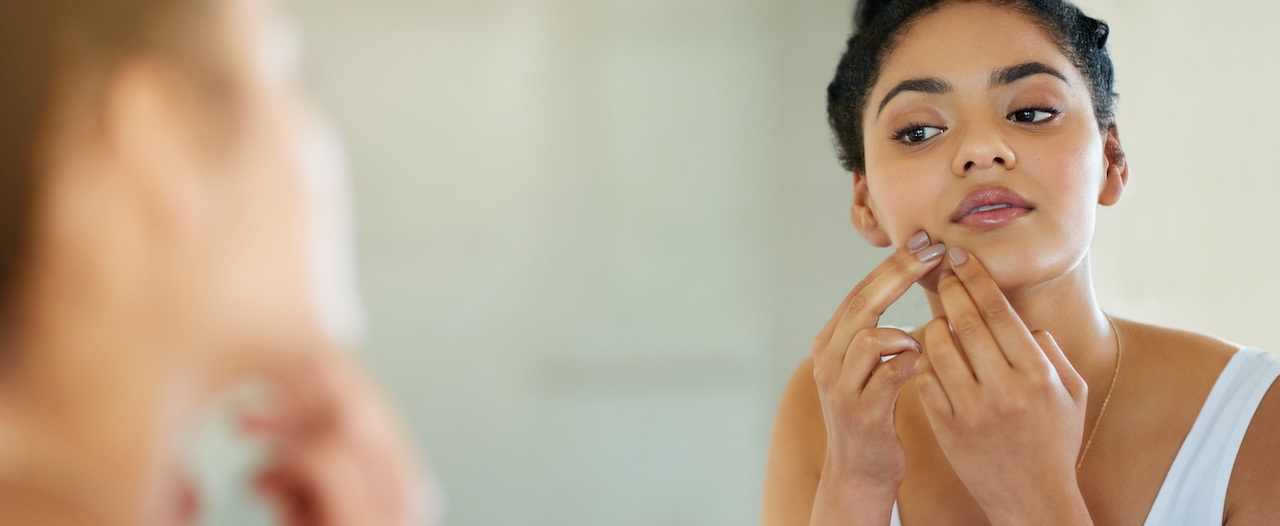If you’ve ever had acne, you’re no stranger to blackheads and whiteheads. These tiny yet terrifying skin symptoms are common and unwelcome guests.
Blackheads
Blackheads develop when sebum and debris collect and clog up the pores in your skin. Sebum contains a dark pigment called melanin, which oxidises and turns black when exposed to air. This is why blackheads have a dark appearance. Blackheads are easy to spot. They look like little slightly raised black dots on the surface of your skin. Blackheads are often found on your nose, shoulders and back, but can also lurk on other areas of your face and body.
Whiteheads
Whiteheads are also clogged pores. They form when sebum, dead skin cells, and bacteria become trapped in your pores. Unlike blackheads, they aren’t exposed to air. The material inside isn’t oxidised and stays white in colour. Whiteheads can develop anywhere on your body. Your nose, chin and forehead are most prone, but these buggers can also develop on your chest, back and shoulders.
Where do they come from?
Clogged pores are the main cause of both blackheads and whiteheads. Your pores can become blocked for many reasons. These include:
- Hormonal changes during life stages like puberty, pregnancy and menstruation can increase the amount of sebum your pores produce.
- Certain drugs like steroids, antidepressants and birth control pills can increase your hormone levels and produce more sebum. This can trigger blackheads, whiteheads and other types of acne.
- If someone in your family suffers from blackheads or whiteheads, you have a high risk of developing them too.
The build-up of bacteria on the skin and irregular shedding of dead skin cells may also put you at risk.
The good news: what you eat and drink does not cause acne! Anyone can develop it, and at any age. The bad news: even if you’ve never had problems with whiteheads and blackheads, you can still get them later in life.
You’ve got them. Now what?
- Avoid squeezing and picking! This will only make them worse and may lead to more breakouts, scarring, and skin discolouration.
- Wash your face with a mild cleanser every morning and evening to remove dirt and oil. Look for products with acne-fighting ingredients like benzoyl peroxide and salicylic acid. Never wash your face more than twice a day as this can irritate your skin and lead to breakouts. Always wash your makeup off before you go to bed.
- Exfoliate your face at least once a week to get rid of dead skin cells and prevent clogged pores.
- Use oil-free moisturisers, lotions and make-up. Any product that contains oil can clog your pores.
- Keep your hair clean, especially if it gets oily quickly. Hair oil can contribute to clogged pores.
TIP Treating whiteheads and blackheads take time and patience. It may be weeks to months before you notice any changes, so hang in there. If nothing seems to be helping, it may be time to see your doctor. He may prescribe medications to help clear and heal your skin.
Can charcoal fight acne?
Activated charcoal has been popular in the media lately. It’s being used in soaps and cleansers as it’s believed to draw impurities and extract toxins from beneath the skin, helping to clear up acne and other skin problems. Unfortunately, there’s no scientific evidence to back this up. There’s very little research that shows charcoal’s cleansing effects on the skin, let alone its effect on acne.
Charcoal is not a miracle worker. It won’t solve your skin problems overnight – nothing will. Speak to your doctor about changing your diet and your lifestyle to help curb the symptoms of skin problems.
References:
- http://www.healthline.com/health/beauty-skin-care/blackheads-vs-whiteheads
- https://www.verywell.com/acne-blackheads-and-whiteheads-1068705
- http://www.healthline.com/health/blackheads#Cause2
- https://www.makeup.com/black-heads-and-white-heads
- http://www.healthline.com/symptom/whitehead
- http://www.livestrong.com/article/131981-charcoal-soap-acne/
- http://www.rd.com/health/beauty/activated-charcoal/

